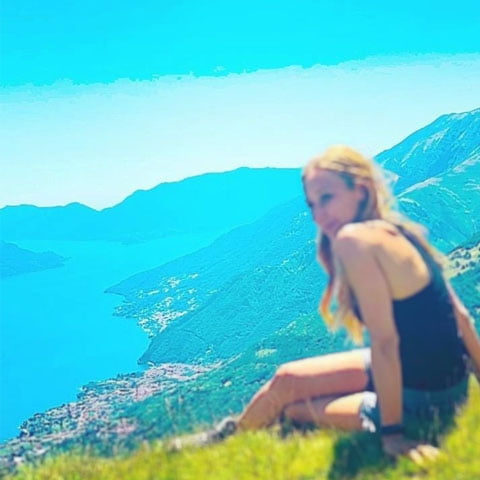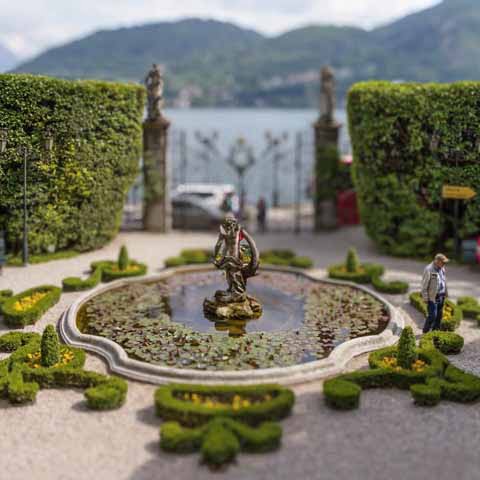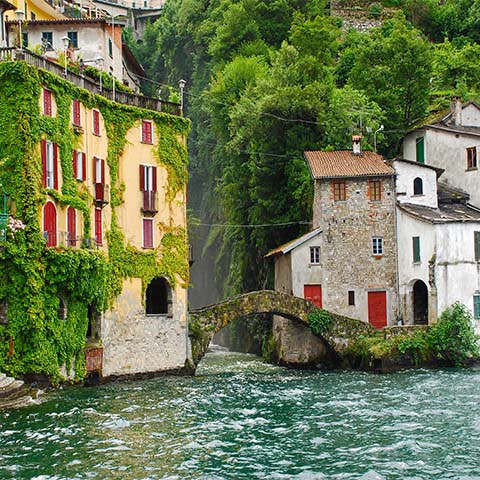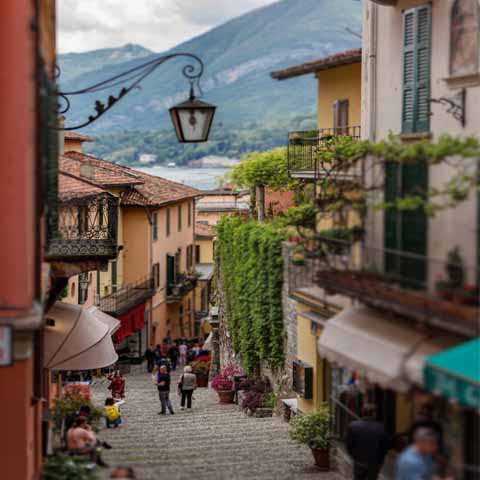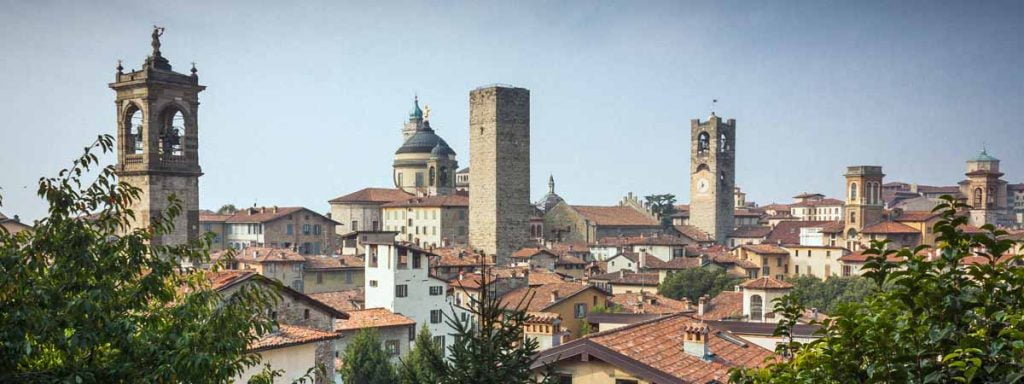Lake Como, or Lario as it is also called, is a natural lake located in a subalpine area belonging to the provinces of Como and Lecco. It consists of three different sectors, popularly defined as branches, the Como and the Lecco basins in the south, and the Colico basin in the north, near Milan. The two southern basins have an almost symmetrical geometry. Lake Como is said to be the deepest in Italy.
A popular retreat for the rich since Roman times, Lake Como is still one of the favorite tourist destinations in the country. It was nominated by The Huffington Post as the most beautiful lake in the world for its microclimate and rich-in-history surroundings.
Geographically, Lake Como is located between the Valley of Po and the Alps, and it presents a very articulated geometry characterized by an inverted Y shape that resembles the shape of a man.
From a morphologic point of view, the lake is a notched natural fjord deeply carved into the mountain slopes of the Como and Bergamo pre-alpine area. The coastline is characterized by a variegated territorial form with alternating slopes, steep cliffs and mild descents overlooking the lake.
Thanks to its strategic position, the area has attracted civilizations sincethe earliest times; the main inhabited centers are Como and Lecco, two municipalities located on the lower tip of the two southern branches. The former is a city with a rich past that shaped the history of the whole region; currently, Como boaststhe richest historical-artistic heritage of Lario.
Prehistory Of Lake Como
Lake Como is now one of the most famous tourist destinations, and its past is equally glorious. During the earliest times, the lake and its region attracted numerous tribes and civilizations. The first permanent settlements in the Como area were perhaps created by the Ligurians during the Polada Culture.
The settlements were placed along the banks of the lakes or swamps in reclaimed zones, while the first stilt houses in the Como region date back to the Bronze Age and were built in an area overlooking the water.
During those times, the primordial villages were built inland, in higher areas protected from invasions and floods. However, the arrival of the proto-Celtic populations during the thirteenth century BC led to a mix of cultures and started a process of transhumance from the steep slopes toward the banks of the lake.
Between the ninth and fourth centuries BC, during the Culture of Golasecca, a strong process of development began, which concluded with the Como area – home of the Comacina civilization – becoming the eponymous area of Golasecca.
At the same time, more specifically between the eighth and sixth centuries BC, the area now belonging to the province of Como witnessed a phenomenonof real proto-urban development that gave this center a particular commercial importance and cultural primacy over the surrounding territory.
This phenomenon was accompanied by structural changes inthe communities through the development of a social hierarchy, which concluded with the formation of stable elites.
The rise of Etruria Padana and the Tyrrhenian expansion along the Po played a fundamental role in this process but had negative economic, political, and military consequences. However, the Etruscan hegemony and the creation of the Brescia-Bergamo-Como-Lake Lugano axis towards the CelticCentral Europe led to a notable welfare boost and determined important cultural changes in the Como district.
Thanks to this fusion between the peoples of ancient Como and the new Etruscan civilization, the area experienced a period of discreet wealth, witnessed by the precious artifacts found in various necropolises. The use of writing disseminated on ceramics testifies a true cultural development.
The importance and richness of Como became more evident in the fifth century BC when the area became the main branch of the Etruscan trade routes between Genoa, Milan, and Central Europe.
Lake Como and the surrounding areas entered a period of decay in the fourth century BC when the arrival of immigrants, majorly Celts and Gauls of transalpine origins, together with the pressure exerted by the Romans, annihilated the Etruscan power and the commercial stream between Italy and the northern Alps that had made Como flourish.
Etruscan villages were considerably reduced, while Gallic settlements emerged in Plesio, Esino Lario, Gudo, and other smaller municipalities.
Taking possession of Como and its territories, the Gauls established a hierarchical society and built numerous castles and defensive walls, including Como’s fortified center.
The Roman conquest found the territory well organized into an Oppidium comensecomprising 28 castles. The conquest began in 225 BC after the break of the Second Punic War, and ended in 196 BC, with the recognition of local autonomies. For about a century, the Roman presence was sporadic until the north of the peninsula became of fundamental interest to ensure adequate security to the Empire, and to satisfy Rome’s expansionist ambitions.
The Roman presence transformed Como into an economically, politically, and military strategic place, and in the same period,Rome conquered the rest of Lombardy too.
Como was awarded Latin citizenship in 89 BC, and in 77 BC a group of 3,000 Roman settlers arrived in the area with the intent to colonize the slopes of the surrounding valleys. But the real founder of the Latin colony near Lake Como was Julius Caesar.
In 59 BC, the aim of strengthening Como’s importance determined Rome to send 5,000 new settlers to the region and founded the Novum Comum.
The new settlement was granted Roman citizenship and was upgraded to municipiumby the Roman Republic. The citizens, therefore, enjoyed full rights as the citizens of Rome and the city received its own Curia administered by four magistrates.
During the first century AD, the urban growth saw an important transformation and the erection of numerous Roman buildings, including a library and a spa, the Roman Forum, baths, temples, and new city walls.
Due to the natural beauty of the territory, Lake Como soon became a favorite tourist destination for the Romans; the condition perpetuated until a century later when the Roman Empire experienced a profound economic and political crisis.
This dark period was quickly overcome by the intervention of Constantine, who fragmented the territory into many autonomous provinces which had the opportunity to consolidate their social situation without external interference.
This marked the beginning of another fortunate period for Lake Como that flourished in a period when the rest of Italywas almost entirely left at the mercy of the barbarian invasions.
History Of Lake Como
During the Middle Ages, Como suffered the invasion of the Goths first and of the Longobards after. In 951, Emperor Otto I gained control over Italy through the support received by his sustainers, including the bishop of Como.
Due to negative feelings and also due to disputes between rival families, Como entered into war against Milan; in the end, Como was besieged, and the Milanese forces burned down most dwellings and villas, while the inhabitants got dispersed.
Through the alliance with Federico Barbarossa, Como found the opportunity to rebuild itself and to aspire to the lost hegemony. With the help of the emperor, the people rebuilt and expanded the city walls, constructed imposing towers and restored the castle, strengthening its structure.
Under Federico Barbarossa, Como lived some years of ephemeral glory during which it took its revenge in the siege and destruction of the city of Milan in 1162. But the imperial army was defeated by the Longobard League in 1176 in Legnano, which led to new struggles near Lake Como and the surrounding areas.
A first attempt to establish the lordship in Como took place in 1276 when bishop Giovanni DegliAvvocati was forced into exile by the Visconti. The result was a new war between Milan and Como, which ended in 1286 with a peace that recognized Loterio Ruscaas pre-eminence over the city of Como.
From 1327, the city fell steadily under the dominion of the Ruscalords who established their hegemony over the city and the surrounding territories. However, the situation lasted for merelyeight years when the Visconti annexed Como to the Duchy of Milan.
The Ruscaattempted to establish their lordship again over Como and the lake upon the death of Galeazzo Visconti, in 1402. Loterio IV conducted an aggressive policy characterized by a period of devastation and massacres until 1416, when Como surrendered to Filippo Maria Visconti.
Between 1147 and 1149, following Visconti’s death, Como experienced a brief period of independence, but in January 1149, Sforza decided to attack Como. The struggles concluded with a rejection of the attack, but towards the end of the century, Ventimiglia assaulted Como again under Sforza’s rule; this time, the odds played in the favor of the Sforza and Como entered a period of rapid decline.
The Sforza ruled the region for quite some time, but the first decades of the sixteenth century saw the territory disputed between the French and the Sforza. The French troops eventually won, and the Ghibellines in the area were forced to leave the city as rebels forced by the allies of the French, the Guelphs.
During the French occupation, the whole Lake Como area, including the cities of Lecco and Como, and many other settlements, were sacked and devastated by both foreign mercenary troops and by the Guelph and Ghibelline partisans.
Subsequently, the Duke of Milan, Francesco II Sforza, returned from exile in 1523 and managed to regain the Duchy of Milan thanks to the Spanishand imperial help, reaffirming his lordship over Como.
But two years later, the Morone conspiracy and the betrayal of Francesco Sforza led to Como being occupied by the Spaniards. Lake Como and the city were involved in the war between the troops of the Sforza and Spain, with the former managing to occupy almost all of Lario and a good part of the eastern Brianza.
Between 1530 and 1531, the region began a kind of cold war between the Dukeand the ProtestantSwiss on the one hand,and between Gian Giacomo di Medici and the Church on the other hand. The Duke claimed his return to Lario, still occupied by di Medici, which triggered the reaction of the latter. However, di Medici didn’t end the struggles victoriously but had to come to a compromise with the Duke.
In 1532 the Duchy of Milan restored its hegemony over Lake Como and the surrounding territories.
From then on, the fate of Lake Como followed the events that interested the Duchy of Milan first and the Lombard-Venetian Kingdom after, up to the unification of Italy. On May 27, 1859, following the battle of San Fermo, Giuseppe Garibaldi freed Lake Como from the Austrian occupation.
The world wars didn’t bring destruction to Como, and in the post-war period, the city entered a prosperous period characterized by a development of the tourism and services sectors.
Today, Lake Como is one of the most famous destinations in the world and boasts Sacro Monte di Ossucio, a popular pilgrimage and UNESCO World Heritage Site.
Archaeology Near Lake Como
Archaeology is well represented near Lake Como in numerous open air sites and archaeological museums. Perhaps the most important archaeological area is Spina Verde, a Regional Park comprising several archaeological sites dating from the Golasecca period. Another noteworthy site is that of Mario Comense, which includes a necropolis with over 200 burial sites.
Recent excavations conducted by the Civic Museum of Lecco also led to the discovery of a Golasecca village near Lecco, while areas scattered throughout the region also hold evidence of the passage of this culture.
Noteworthy is also the Roman villa of Sant’Andrea in Biassono; other Roman villas discovered near Lake Como present precious mosaics and artifacts exhibited in the museums of the region.
The Bronze Age is well represented, especially in the archeological areas of Piani d’Erna and Piani di Barra.
Among the museums, we should mention the Civic Archaeological Museum in Como, but also the archeological itinerary on Comacina Island.
Don't just see Italy, live it.
Your dream trip to Italy has never been closer
No more endlessly scrolling travel sites. Our travel experts will craft the perfect, one-of-a-kind trip just for you.

300+
DESTINATIONS
We offer more Italian destinations than any travel site. Do and see more with Trips 2 Italy.
1 (of a kind)
ITINERARIES
Because your dream trip to Italy should be designed for you, not for the masses.
100%
PEACE OF MIND
From flights and accommodations, to food and activities - we take care of every detail.
